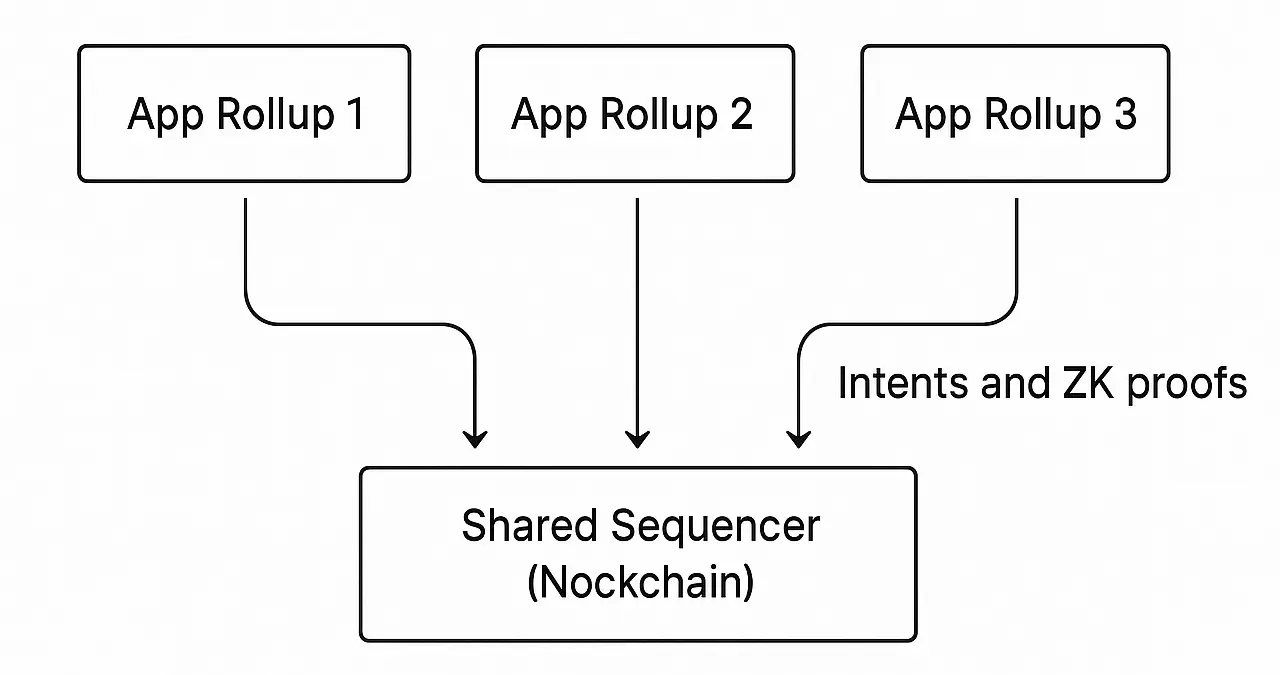
Composable App-Rollups
While Nockchain today has a simple UTXO-based transaction model, it is designed to provide high-throughput settlement, programmability, and censorship-resistant data-availability over time. Nockchain achieves these properties through minimizing onchain execution and providing native protocol primitives that enable offchain app-rollups.
The fundamental difference between Nockchain’s offchain app-rollup model and traditional smart contracts lies in the separation of execution from settlement. Traditional smart contracts execute logic directly onchain—every validator node redundantly verifies and executes every single transaction. This inherently limits scaling, as throughput is bounded by the computational resources required for redundant execution by the entire network. Complex operations become prohibitively expensive or impossible to perform efficiently onchain due to gas constraints and shared global state contention.
In contrast, Nockchain pushes the execution of application logic entirely offchain, employing zero-knowledge proofs (ZKPs) for cryptographic verification of correct computation. Developers execute application-specific logic offchain, then produce succinct proofs of correctness that are subsequently verified onchain. Because validators only check these proofs instead of re-running computations, Nockchain dramatically improves scalability, removing the centralizing linear execution bottleneck. Offchain apps handle computation independently and in parallel, significantly increasing throughput and allowing far more computationally intensive operations without burdening the onchain settlement layer.
However, this improved scalability and efficiency introduces a latency tradeoff. Onchain smart contract systems typically offer predictable latency; users submit transactions and wait only for a block confirmation—often seconds to a minute—to achieve finality. Nockchain, operating similarly to Bitcoin in block intervals of approximately ten minutes, inherently has higher onchain settlement latency. This choice is intentional, prioritizing chain stability and a low orphan rate over faster finality. Yet this longer block interval is carefully mitigated from the user’s perspective through preconfirmations. Because app logic executes instantly offchain, applications built on Nockchain can deliver immediate feedback to users. Users experience near-instant responses to their interactions, such as trades, game actions, or state updates, despite the longer underlying settlement times. As such, Nockchain leverages offchain execution to provide users with responsive, low-latency interfaces that resemble Web2-like interactions, even though underlying onchain finality remains slower.
A critical component of blockchain usability is atomicity—ensuring multiple actions occur completely or not at all—and composability, the ability of applications to interact and build upon each other seamlessly. Ethereum-style smart contracts inherently achieve atomic composability through synchronous execution within a single transaction. Multiple smart contracts execute in a predetermined order within one atomic state change, a powerful simplicity advantage of traditional smart contract platforms.
Nockchain approaches atomicity and composability differently. It leverages an intent-based transaction model rather than direct smart contract invocations. Users or applications express high-level intents, specifying desired outcomes without explicitly scripting every intermediate step onchain. Offchain application logic then processes these intents, producing state updates and cryptographic proofs demonstrating correct intent fulfillment. Multiple intents across different offchain applications can be aggregated into a single cryptographic proof. When posted to the Nockchain settlement layer, these aggregated proofs simultaneously and atomically update the state for all related intents, effectively emulating synchronous atomic composability in an asynchronous, proof-based model. Nockchain acts as a shared sequencer–a single settlement layer–for all its app-rollups. Shared sequencing enables aggregation of transactions in batches and atomic composability.
This intent-based approach solves composability by abstracting transaction execution away from explicit onchain state changes. Instead, composability emerges naturally at the proof-validation layer: each intent specifies outcomes clearly, allowing multiple offchain apps to cooperatively generate interdependent state updates that fulfill complex user scenarios. As a result, even though each offchain app operates independently, their proofs coalesce at the onchain settlement layer, where validators ensure atomic, all-or-nothing acceptance of aggregated intents.
This novel approach comes with developer tradeoffs. Developers manage offchain apps, proofs, and intent coordination rather than direct onchain function calls. However, developers benefit from a simpler onchain execution model with well-defined declarative logic. The offchain Nockapp execution environment feels like traditional Web2 apps and is simpler to test, debug, and iterate on. The Nockapp framework standardizes developer experience and provides a modular set of libraries and capabilities.
Nockchain’s offchain app-rollup model achieves significant scaling advantages by delegating computation offchain, greatly increasing throughput and computation capability beyond traditional onchain smart contract limits. User experiences benefit from instant offchain responsiveness through pre-confirmations, effectively masking the underlying longer settlement latency. Atomicity and composability are addressed through intent-based aggregation, enabling powerful cross-app interactions without sacrificing the atomic guarantees essential for secure and predictable blockchain interactions. While introducing novel tradeoffs, this model provides a scalable and efficient alternative to the traditional smart contract approach.
This article is not investment advice. Zorp does not issue $NOCK, does not create a market in $NOCK or guarantee that any such market will be made.